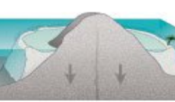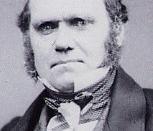The primary mission of the Beagle was to map the coastline of southern South America and take oceanographic measurements (currents, bathymetry, etc) as well. Darwin's job as the ship's naturalist was to observe everything, write it all down and collect as many specimens as possible. It was his job to record the weather, geological features, plants, animals, fossils, rocks, minerals, indigenous people and anything else that he saw. It was through this voyage that Darwin's innate ability to observe in great detail and think "large" began to assert itself.
Among Darwin's many marine biological observations, Darwin had an opportunity to study coral fringing reefs, barrier reefs and atolls in 1836 while in the Indian Ocean. Fringing reefs are coral reefs that surround an island and atolls are "rings" of coral with a lagoon in the middle. Darwin was intrigued by the formation of atolls and their resemblance to fringing reefs surrounding volcanic islands.
An enthusiastic student of geology, Darwin suggested that atolls represent a latter stage of volcanic island development where the island sinks into the ocean over time. As the island sinks, the corals continue to grow around the fringe of the island until the island disappears leaving only the corals, a "perfect atoll", as he calls it. Many decades later, geologists took cores of an atoll and confirmed their volcanic origins, just as Darwin described. In addition, Darwin's classification scheme of tropical corals reefs, barrier reefs and atolls--is still used today.
While exploring the island of Sao Tiago, part of the Cape Verde islands near Africa's northwest coast, Darwin came upon a cliff. High up on the cliff he noticed a band of white rocks. It ran along the cliff for several miles. After closer inspection Darwin noticed that the white rocks were made of seashells. This finding...


